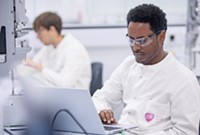Advertisement
Grab your lab coat. Let's get started
Welcome!
Welcome!
Create an account below to get 6 C&EN articles per month, receive newsletters and more - all free.
It seems this is your first time logging in online. Please enter the following information to continue.
As an ACS member you automatically get access to this site. All we need is few more details to create your reading experience.
Not you? Sign in with a different account.
Not you? Sign in with a different account.
ERROR 1
ERROR 1
ERROR 2
ERROR 2
ERROR 2
ERROR 2
ERROR 2
Password and Confirm password must match.
If you have an ACS member number, please enter it here so we can link this account to your membership. (optional)
ERROR 2
ACS values your privacy. By submitting your information, you are gaining access to C&EN and subscribing to our weekly newsletter. We use the information you provide to make your reading experience better, and we will never sell your data to third party members.
Biotechnology
Movers And Shakers
Genentech’s R&D chief Michael Varney on the future of drug discovery
The research head weighs in on difficult targets, neuroscience, and the role of AI in medicine
by Lisa M. Jarvis
July 30, 2019
| A version of this story appeared in
Volume 97, Issue 31

In Michael Varney’s nearly 15 years at Genentech, a lot has changed. He arrived in 2005 to build a small-molecule business at a drug company known as primarily an antibody shop—an evolution from its start as a protein firm. Now, as research chief, Varney oversees a pipeline that includes the usual small-molecule and antibody suspects but also more unconventional drugs: antibody-drug conjugates, antisense oligonucleotides, personalized cancer vaccines, and more.
Varney and his team have spent much of the past year ruminating on what they think R&D will look like 5 years from now. One conclusion: the molecular landscape will be even more complex. “If you look out into 2025, there’s one thing I’m pretty darn sure is going to be real: the kinds of drug modalities are going to be more diverse than they are today,” Varney says.
It’s a necessary evolution. Good drug targets—the kind that scientists are fairly positive will, if hit properly, change the course of a disease—are increasingly rare. “The worst-case scenario is when a biologist spends 3 years churning up a target and then drug discoverers say, ‘Hey, that’s a really good target, but we can’t find you any leads,’ ” Varney says. Genentech executives are doing “essentially everything” they can to never be in that position.
Vitals
Company: Genentech
Title: Executive vice president, Genentech Research and Early Development (gRED)
Education: California Institute of Technology, PhD, organic chemistry
Professional highlight: “Being given the privilege to lead gRED”
Recent TV binge: Animal Kingdom
Favorite band: “Sublime. I am a big fan of all forms of ska music. Also, my wife Jennifer Ball and I are founding members of the rock band Fingerpuppets.”
Part of that effort is ensuring the firm’s researchers feel empowered to explore tough science. When Varney took over as head of research in 2015, he told C&EN that his constant reminder to staff is that “innovative environments take action; noninnovative environments analyze.” That refrain led his team to soul search about the attributes that foster innovation.
“Culture really matters here,” he says. “Is it one where people have to ask for permission all the time? Or is it one where it is expected that scientists will go run experiments?”
Varney strives for the latter. “If you really want to innovate, you have to give scientists the freedom to explore and not have some endless pressure to deliver a tangible outcome like a molecule. Sometimes it takes time to figure things out.”
The exploration of new, sometimes wacky ideas is critical in therapeutic areas where complex human biology continues to stymie scientists. Neuroscience, an area many drug firms have abandoned, is a prime example of a field in need of creative thinking.
Genentech has stuck with it. Varney points to advances in science that allow researchers to consider neurodegeneration “in a holistic sense.” For instance, scientists now recognize that diseases like Alzheimer’s and amyotrophic lateral sclerosis progress along similar biological pathways, opening up opportunities to try new interventions.
Indeed, Genentech and other biotech companies are now studying the immune system’s influence on the genesis of neurodegenerative diseases. That has led the big biotech firm to work on altering immune cells to either be more helpful or stop wreaking havoc themselves.
Another neuroscience research focus is the blood-brain barrier, which protects our most precious organ from pathogens but also keeps out many small-molecule drugs and nearly all antibodies. Varney notes that Genentech has a group devoted to developing ways to sneak drugs past that physical border.
Genentech is also looking beyond conventional medicines to treat neurodegenerative diseases. “There is an increasing body of knowledge about how to manipulate cell lineages and specific cell types or populations,” Varney says. Imagine, he suggests, a medicine that instead of “simply slowing down the decline of your cognitive function could regrow tissue.” The idea might sound far fetched, but the allure has made regenerative medicine “an area of interest” for Genentech in neurodegeneration and elsewhere, Varney says.
While Varney contemplates approaches to drug discovery that might sound like science fiction, there’s one futuristic tool he’s less bullish about: artificial intelligence. In January, Varney found himself at the center of a mini social-media storm after a journalist tweeted on comments Varney made about AI in drug discoverywhile on a panel during the J.P. Morgan Healthcare Conference. The tweet suggested that Genentech’s research chief had a less-than-favorable view of the technology.
Mentioning the incident today seems to rankle Varney. The even-keeled executive sounds frustrated as he explains that his comments were misconstrued—that he wasn’t critiquing AI in and of itself but rather the hype around what it currently can and cannot do.
In fact, Genentech has made significant efforts to use machine learning to support drug development, and the R&D chief sees a few specific places where AI is likely to make an impact in the near term. But the technology is still maturing, he says, and a critical question is: “How do you develop an AI or predictive tool that can do something more than just tell you what you already know?”
Varney points to using AI to find small-molecule inhibitors. Experienced medicinal chemists know that their chances of finding a molecule that safely and potently blocks a target are higher when they explore a diverse array of chemical backbones. Yet current AI sifts through only data sets of molecules known to fit into the target’s active site and not those that “jump out of that groove,” Varney says. In other words, there’s still work to be done to coax computers into offering up an unexpected new class of structures.
A more likely place for AI to improve productivity in the near term is the vetting of molecules designed by chemists. For example, industry already has reams of well-organized data on how existing drugs break down in the body, and computers should soon be able to draw on that information to predict how a human will metabolize a new small molecule. Varney also says AI will make a near-term difference in the design of synthetic routes for building molecules.
Longer-term goals, Varney says, include building tools that can sort molecules into classes and developing databases of antibodies that are robust enough to allow computers to relate antibody sequences to physical properties.
While the computers catch up, drug hunters at Genentech continue to apply their decades of knowledge to finding novel drugs. “Molecule making is probably more valuable now than it’s ever been,” Varney says.




Join the conversation
Contact the reporter
Submit a Letter to the Editor for publication
Engage with us on Twitter